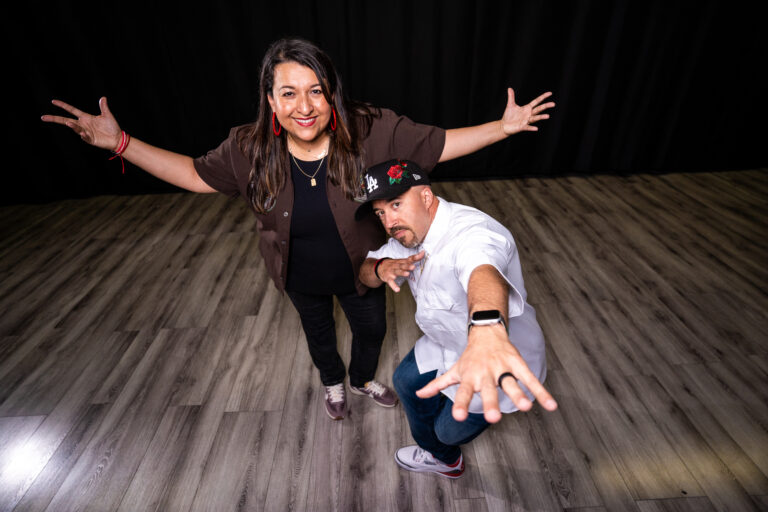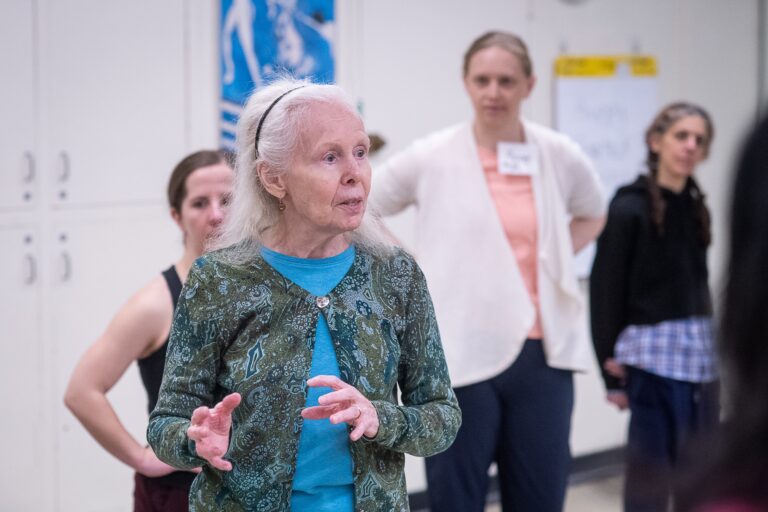Marc Crousillat, here performing Trisha Brown’s Set and Reset, got his first professional dance gig via a guest artist he’d worked with at the University of the Arts.
Moe Renteria knew she wanted to study modern dance in college. What she didn’t know was that “modern” can be very different from program to program. Growing up, she’d studied Horton technique, with its clean, long lines and lateral Ts. So when she walked into her first modern class at Loyola Marymount University, the ooey-gooey contemporary approach felt foreign. “Before, I had thought, ‘Modern is modern,’” she says. “I didn’t really dig as deep as I should have in my research.” Her surprise ended up being a happy one—she embraced the opportunity to study new styles—but it’s something that, in retrospect, she wishes she’d asked about early on.
The college search can be tricky for dancers who only have the time and resources to audition for a handful of programs. Here are key questions high-schoolers should ask to whittle down their lengthy wish lists—and, in the process, realize what’s important to them.
Finding the Dance Department of Your Dreams
What degrees are offered?
At its most basic, the primary difference between a bachelor of fine arts (BFA) and a bachelor of arts (BA) is the time spent in dance-specific courses. Most BFA programs adopt a conservatory approach, with a focus on daily technical development, and enrolled students often aspire to dance professionally. BA programs, on the other hand, require fewer studio credits, with more emphasis on academics; students might be interested in careers in teaching, physical therapy or other dance-related fields.
But this isn’t the case across the board. That’s why it’s important to ask: What’s the atmosphere like? Does the program have a fast-paced conservatory feel or a low-key, exploratory vibe? What are the daily technique requirements? Does the program place a greater emphasis on technique or choreography?
What’s the median technique level in the program?
Instead of asking this question outright, University of Arizona BFA grad Brittany Churchill recommends observing middle-level classes—don’t just sit in on the advanced classes. Ideally, dancers should choose a program where their own level falls roughly in the middle. This ensures that there’s room to grow.
What styles does the program emphasize?
Modern dance isn’t the only genre with a variety of styles. Ask about ballet and jazz, too. At Loyola, for instance, students study both contemporary and classical ballet. “One semester our pointe variations class will be classical, and one semester it will be contemporary,” says Renteria.
If you find a program that offers the style you’re looking for, ask whether there are multiple levels in that style—this will show how strongly the program is invested in that technique. Finding out what repertoire students perform will also give insight into the training emphasis. (Of course, keep in mind your style preferences may change as you grow in college.) Ask, too, about dance-related academics that will round out your education, like pedagogy, composition, dance history and career workshops.
What are alumni doing?
Rather than focusing on one or two superstars who made it big, look at an overview of alumni. For example: In her search, Churchill noticed that many Point Park alumni headed for Broadway after graduation. Similarly, dancers who attend partnership programs between universities and professional companies—like the Ailey/Fordham BFA program and Alonzo King LINES Ballet BFA program at Dominican University—often go on to join those companies.
Who does the school bring in as guest artists? And what kind of interaction do students have with them?
Asking about guest artists and residencies is important—especially how long guest artists stay at the school and in what capacity they participate. “Ask whether a guest artist would have a semester or yearlong residency, or if they would be there for a week, or a day,” says Churchill. “Are they just teaching choreography or also investing in your technique? Do you really get to know them? If it’s a guest artist you eventually want to work for, it could be life-changing.” Marc Crousillat, a recent University of the Arts graduate, got his first professional job postgraduation from a guest artist he’d worked with in school, Netta Yerushalmy.
How many opportunities do students have to perform and choreograph?
In some programs, dancers wait until their junior and senior years to perform; at others, they can perform as freshmen. Some schools have more dance majors than there is space for in concerts, so many dancers turn to student-run groups for performance opportunities. The chance to choreograph may only be offered to upperclassmen.
The Bigger Picture: College Life
Where’s the college located?
Crousillat knew that he wanted to go to school in a major city—he wanted to be exposed to the wider dance world and work with teachers currently engaged in that scene. Churchill, meanwhile, had gone to high school near New York City and was looking for more of an oasis where she could zero in on dance and college life. (Keep in mind that the weather can influence a student’s experience, too.)
How big is the school?
Is it a large university with 20,000 students and lecture halls or a small campus with 1,500 students? Does the college have an overall arts focus, or is there a wide variety of majors?
For Churchill, “it really came down to the kind of college life I wanted.” She liked the idea of having access to all the perks a large university has to offer. Crousillat, on the other hand, was looking for strong arts-based academics and as much one-on-one learning as possible.
How’s the campus?
For some dancers, dorms may be the last thing they think to check out. But they’re your home base during a big transition—the atmosphere can influence a dancer’s overall happiness and well-being. Finding nutritious food is central to a dancer’s success, too. Dance students may end up in rehearsal during normal cafeteria hours, so make sure that schools offer healthy food options, even after the cafeteria has closed. DT
Ashley Rivers is a writer and dancer in Boston.
Bonus Round
Still can’t decide? The answers to these additional questions might help:
- What’s the size of the dance program?
- Are dance majors allowed to have jobs?
- Can dance majors double-major or add a minor?
- What’s a dancer’s daily schedule like? What’s the dance/academics balance?
- Are there injury-prevention classes offered and/or physical therapists available?
- What’s the program’s male-to-female ratio?
- Does the school have any partnerships with dance companies or other
professional connections?
- Can students intern or apprentice with local companies for credit? —AR
Photo by Emmanuel Joannin, courtesy of Trisha Brown Dance Company



